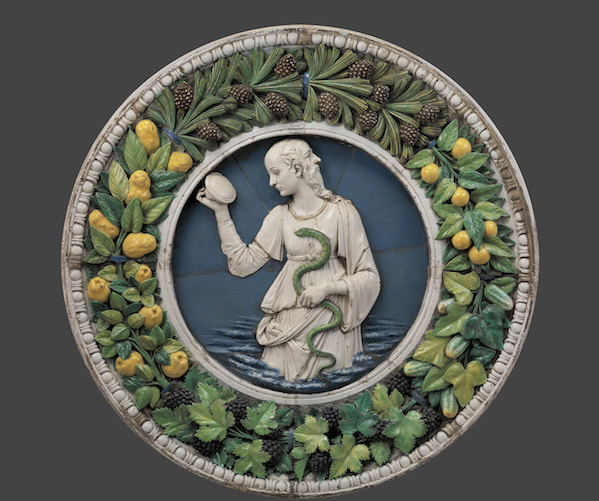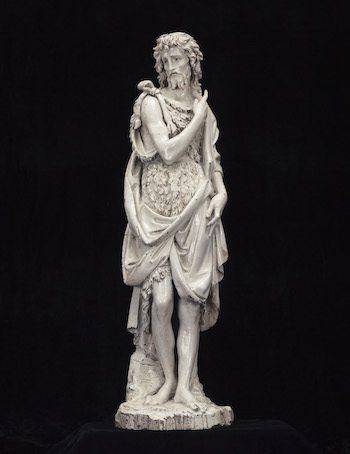Visual Arts Review: Renaissance Sculpture — Colorful for Five Hundred Years
I used to be skeptical of della Robbia sculpture but, after taking a closer look at the recently opened exhibit at the Museum of Fine Arts, I changed my mind.
Della Robbia: Sculpting with Color in Renaissance Florence at the Museum of Fine Arts Boston, MA through December 4.

“Prudence” (before conservation), Andrea della Robbia, Ca. 1475. Glazed terracotta Photo: Museum of Fine Arts, Boston.
By Kathleen Stone
The Victorian art critic John Ruskin once said he disliked della Robbia sculpture: the bright colors were “vulgar.” Later, he changed his mind and proudly displayed one of his own. Bright colors were the point, of course, of the glazing technique developed by Luca della Robbia in Florence in 1430. Onto clay harvested from the banks of the Arno River, sculpted into figures and doused with mineral pigment, the della Robbia workshop painted its secret formula glaze. Thanks to Luca’s innovation, the sculptures’ colors are as shiny and vivid today as when they emerged from the kiln, five hundred years ago.
I have to admit that I, too, used to be skeptical of della Robbia sculpture. But I took a closer look at the recently opened exhibit at the Museum of Fine Arts and, like Ruskin, I changed my mind, not just due to the rich palette, but because of the expression of humanity in each piece.
The Visitation, one of the earliest works in the show, was sculpted by Luca della Robbia himself. It depicts the Virgin Mary visiting her elderly cousin Elizabeth. Both are pregnant: one through Immaculate Conception, the other despite old age. Luca positioned the women according to the prevailing Renaissance convention, with Elizabeth kneeling before Mary in a sign of respect for the mother of God. Mary’s face is smooth and round, whereas Elizabeth’s face is distinctly older, with wrinkles and sharp features – it is an understated portrait of women across generations. Both figures are glazed in a lustrous white that is both soft and intense, a color all its own that transforms the clay into a luxurious, marble-like substance.

Resurrection of Christ, Giovanni della Robbia, Ca. 1500-1520, Glazed terracotta. Photo: Museum of Fine Arts, Boston.
Andrea della Robbia, Luca’s nephew, sculpted a roundel of a young woman who personifies the virtue of prudence. Here we can see the hallmarks of what became the della Robbia style — striking color and the three-dimensional garland. The Prudence figure (who, for allegorical purposes, is two headed) is bright white, but she stands against a deep blue background, holding a snake. The serpent, a symbol of wisdom, cuts a graceful, dark green line against her white robe. Around the roundel is a deeply cut, three-dimensional garland, saturated in green, yellow, blue, and brown. The exquisite modeling and rich hues make the pine cones, lemons, grapes, and other fruits practically pop off the surface.
The garland was an innovation of Andrea, replicated by his son Giovanni in his relief of the resurrection of Christ. But gone is the simple, one-to-one expressiveness of the earlier Visitation and the understatement of Prudence; the Roman soldiers who see the resurrected Christ wear finely detailed clothing and carry elaborate weaponry, ornate accoutrements that go hand-in-hand with their melodramatic facial expressions of awe and fear. Also pictured is a member of the Antinori family who commissioned the piece, along with his coat of arms, a further innovation of this generation.
Giovanni also sculpted the beautiful figure of Judith, the Old Testament matriarch who saved her people by slaying the Assyrian general Holofernes. She stands erect, sword above her head, Holofernes’s head at her hip. Again, the piece’s color inevitably commands attention — a deep blue ruffled gown edged in golden yellow, light brown hair flowing past Judith’s shoulders, her victim’s hair and beard a dark brown. The heroine was a popular figure in Renaissance and Baroque art, and Giovanni envisions her as strong and sensual, cunning enough to seduce the enemy and kill him.
The show also includes examples of work by other sculptors, some glazed in the della Robbia workshop and some using a pirated version of the family’s formula.

Saint John the Baptist, Giovanni Francesco Rustici, About 1505–15, Glazed terracotta. Photo: Museum of Fine Arts, Boston.
Giovanni Francesco Rustici’s St. John the Baptist is a delicate, expressive figure, all in white. The white here is the color of café au lait, heavy on the milk, and it gives considerable depth to the texture. The saint wears animal skins but, instead of appearing heavy, the skins seem almost frothy. With his torso turned to the left and his head to the right, the figure strikes an elongated, idealized pose. As a young man, Rustici worked alongside Michelangelo and was particularly influenced by Leonardo. This piece proffers some of the delicate and expressive detail one would expect to see in Leonardo’s work. Glazed in the della Robbia workshop, the surface remains glossy and smooth.
When the family of della Robbia sculptors petered out after three generations, a competing workshop tried to replicate the glazing formula, A trio of pieces by Santi Bugliono are here as examples of the competitor’s work. All three exploded while in the kiln, perhaps because of their large size, but they were knit back together. The most interesting innovation, apart from the figure’s nearly life-size proportions, is that their heads, hands, and feet were left unglazed so that the matte brown skin contrasts with their glossy brown robes.
In addition to the usual explanatory tags on the wall, the show’s curator has posted information about the conservation process. When conservators were disassembling and cleaning the pieces in preparation for the show, they made discoveries about how the artists intended their work to be displayed, and that interesting information is contained in the conservation notes. And it is worth pointing out that today’s Antinori family, whose forbearer commissioned the Resurrection of Christ relief, underwrote its conservation.
This is a compact show, with works drawn from American and Italian collections. The exhibition nimbly captures a century when one family’s technical innovation propelled sculptors forward in their ability to convey human expressiveness and, amazingly, it preserved the artists’ work for us to appreciate in its original form.
Kathleen Stone lives in Boston and writes critical reviews for The Arts Fuse. She also is at work on several longer projects. She holds graduate degrees from the Bennington Writing Seminars and Boston University School of Law, and her blog can be found here.
Tagged: Della Robbia, Kathleen Stone, museum-of-fine-arts-boston, Renaissance Florence
